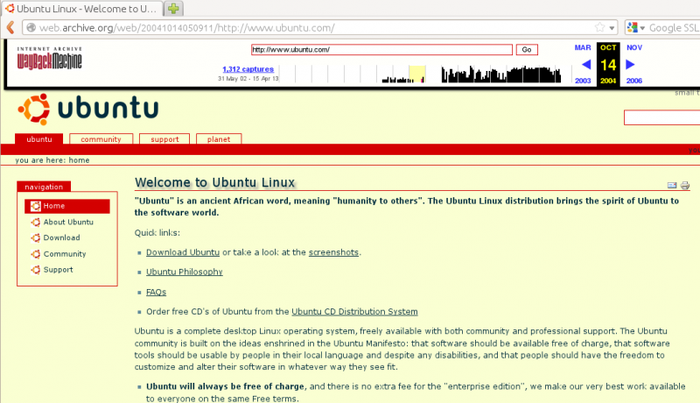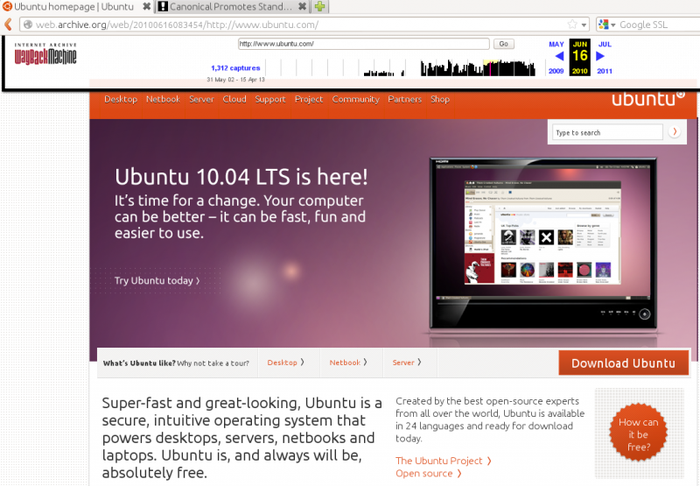Tracing Ubuntu's Branding Evolution Since 2004
Ubuntu has changed a lot since its early days, as we noted earlier this week. So, too, has what we could call the Ubuntu brand, or the image of the operating system as Canonical presents it to the world. And with Ubuntu 13.04 about to debut in just a couple days, this seems like a particularly appropriate moment to consider how Ubuntu and Canonical as a brand have evolved over time to become what they are today.

Ubuntu has changed a lot since its early days, as we noted earlier this week. So, too, has what we could call the Ubuntu brand, or the image of the operating system as Canonical presents it to the world. And with Ubuntu 13.04 about to debut, this seems like a particularly appropriate moment to consider how Ubuntu and Canonical as brands have evolved over time to become what they are today.
Few mediums reflect the development of the Ubuntu image more than the Ubuntu home page (do we still use that word?) itself. Back in the fall of 2004, when Canonical introduced the first version of Ubuntu, 4.10, the website and the branding on it were largely a product of their times, as this screenshot shows. (Click here for a full look.)

Beyond the aesthetics, which look antiquated today, the message in the text was also very different from the one Canonical focuses on now. In 2004, the Ubuntu website touted “humanity to others” and the openness of the Ubuntu project. Commercial considerations took a back seat to community engagement—which made sense at that time, when Ubuntu was struggling for mind- and marketshare within an open source ecosystem dominated by larger, better-established Linux distributions.
The Ubuntu message began to change in the months leading up to the Ubuntu 7.04 release, when ubuntu.com stopped mentioning African philosophy. The community-centered image was still present on other parts of the site, but the home page by this time drew visitors’ attention to the two main variants of Ubuntu, Ubuntu desktop and Ubuntu server, that they might want to put to use in production environments. (Since archive.org seems not to have proper CSS files for the Ubuntu site from this period, it is hard to reconstruct visually, but the basic elements are evident in examples like this March 16, 2007, snapshot.)
But the biggest steps in making the Ubuntu brand what they are today began in the fall of 2010. Then, Canonical employees started clarifying what the different usages of “Ubuntu” itself—an operating system, a philosophy, a community—actually meant. The company took this work a step further the next spring, when it stopped differentiating between the various “editions” of Ubuntu for different hardware platforms. After that, the operating system became simply “Ubuntu,” whether you ran it on a laptop, PC, server or phone (not that it actually worked on phones at the time, but Canonical was thinking of the future).
Meanwhile, Canonical had begun updating the Ubuntu visuals in 2009, when it utterly revamped the system theme. The website got a new look the next year, with the introduction of the sleek artwork and logos that remain central to Ubuntu branding today.

The visual and semantic trends that Canonical developed over the last few years have led directly to the Ubuntu image it promotes now. Aesthetically, the Ubuntu home page has changed little since around 2010. The message it conveys also focuses on Ubuntu’s ease of use and cross-platform integration—points hardly mentioned in earlier material on the operating system.
A lot, then, has changed when it comes to Ubuntu’s look and feel since the heady days of 2004. Those changes reflect the technical evolution of Ubuntu from a Linux-based operating system mainly for personal computers to the platform for PCs, servers, corporate workstations, tablets, smartphones, TVs and the cloud that it has become today. They also are evidence of the development of Canonical’s business strategy, which it has diversified and professionalized over the years. And with the introduction of Ubuntu 13.04 and beyond, expect that evolution to continue.
About the Author
You May Also Like


